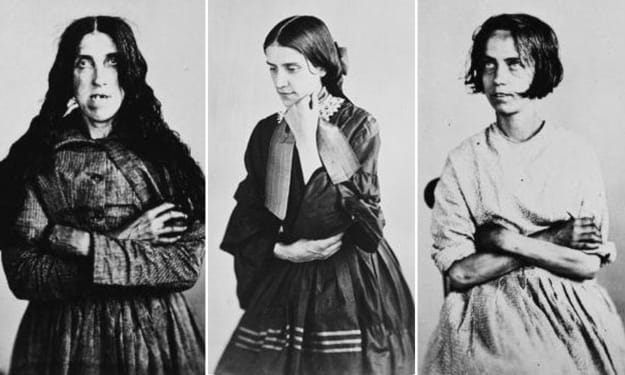
Henry Cotton was an American psychiatrist, he had an interesting insanity theory. He was convinced that if he removed the infected teeth of mental patients it would cure them of their insanity. He was the protégé of Adolf Meyer of John Hopkins. Dr. Henry Cotton was convinced that untreated infections caused insanity.
Dr. Cotton became a medical doctor and superintendent of the Trenton Psychiatric Hospital in 1907. He then wasted no time in proposing and carrying out his procedures that were to "save" mental patients.
After he took over Trenton Psychiatric Hospital, the doctor started to remove infected teeth from his patients. But, this didn't always cure them of their madness. But, it did stop them from speaking clearly and eating properly.
Cotton concluded that the reasons his surgeries weren't always successful was that the infection was spread too far in the body. So, it was necessary to remove other infected body parts, this ranged from tonsils, stomachs, gallbladders, testicles, ovaries, and colons. Or so the doctor claimed.
Dr. Cotton reported that he was managing to cure 85% of his patients. His colleagues were impressed and eager to embrace his methods. Parents of mentally unstable children were eager to get a slot in Cotton's tight schedule. If it wasn't possible, they would insist that their own doctors replicate the surgeries.
Cotton was a famous man, he was being acknowledged both in America and Europe for his radical and supposedly successful treatment.
As he continued to perform the surgeries, his patients' death rate started rising. One in three patients died after undergoing the treatment.
Many patients in the institute recognized the danger of the surgeries and they refused to go to the operating theater. So, they would be dragged there all while they resisted and screamed.
The mortality rate was at 30%, Cotton recognized the risk but he claimed that most patients died because they were already in poor physical condition.
Not everyone was convinced by Cotton, some psychiatrists were skeptical of the surgeries. In addition, allegations surfaced that he was mistreating his patients.
Cotton managed to appease his critics. He replaced all of his male nurses with female ones and escaped condemnation.
The New York Times wrote this in 1910:
The men naturally are too rough with patients, and that male patients are not so excited by the approach of women nurses. Cotton believes the presence of women nurses is restful to the diseased mind.
In 1924 a proper investigation took place into Cotton's methods. Dr. Phyllis Greenacre, another former student of Meyer, led the investigation.
Greenacre suspected that there was something amiss about Cotton and his procedures. She discovered that the hospital environment was detrimental to the mental well-being of its patients, she also noted that Cotton was "singularly peculiar."
The patients in the facility disturbed Greenacre as well. It took her a while to realize that this was because most of the patients had no teeth. Greenacre found that the staff records were chaotic and Cotton's data was contradictory.
Greenacre was determined to get to the bottom of the case. So she singled out 62 patients that had been victims of Cotton's aggressive surgeries. Her discoveries were shocking.
17 patients had died right after Cotton's surgeries and several others suffered for a few months before they passed away. Those deaths were never included in the mortality rate.
In Greenacre's other findings it showed that only 5 patients recovered completely while three improved but remained symptomatic. The remaining patients were unimproved.
Greenacre was more suspicious than ever. She got in touch with discharged patients who had supposedly improved or had been cured. However, after she interviewed the patients, Greenacre found that they were still mentally unstable.
While Greenacre was carrying out her investigation, a New Jersey State Senate Committee developed an interest in the asylum. Cotton was no longer as popular as he once was.
What followed was described as "a parade of disgruntled employees, malicious ex-patients, and their families, testifying in damning detail about brutality, forced and botched surgery, debility and death."
During these investigations, Cotton conveniently mad. Greenacre's damning report was ignored and buried while New Jersey State Senate lost all their interest in the asylum, this led to Cotton miraculously recovering.
His madness was apparently caused by some infected teeth. Once he removed the teeth, he felt much better. So, he went on to remove all of his wife's teeth as well as the teeth of his two children.
Cotton's treatments were back in demand. Cotton continued with his surgical procedures in Trenton and he traveled the states and Europe and gave lectures, he opened his own private clinic where he welcomed wealthy patients desperate to have loved ones treated and cured of madness.
In the 1930s, Cotton retired and he became medical director emeritus. This didn't stop him from concocting a new idea.
This new theory was even more radical, he thought it would be a good idea to carry out colectomies on children in order to prevent insanity and to stop them from engaging in bad habits, such as masturbation. He started to criticize dentists, he found it strange that they tried to fix teeth instead of pulling them out.
Cotton was still continuing his controversial surgeries at Trenton and was still under fire. In the early 1930s, an investigation was initiated by the hospital's board and it was carried out by the director of New Jersey Department of Institutions and Agencies.
There were records of 645 patients that underwent Cotton's surgeries and were examined and compared to 407 patients who had not undergone surgeries. It was found that the recovery rate was higher than those patients who had not been treated by Cotton.
Cotton and his supporters fought against the allegations that their surgical procedures were harmful. Cotton died of a heart attack in 1933 in the middle of the allegations.
Henry Cotton and his assistants pulled more than 11,000 teeth and performed 645 major surgeries. Cotton killed hundreds of innocent patients and maimed countless of others. The Times' obituary declared that "all must lament the loss of this great pioneer whose humanitarian influence was, and will continue to be, of such monumental proportions."
About the Creator
Shelby
Just a girl who loves to write about paranormal and life stuff. Please enjoy






Comments
There are no comments for this story
Be the first to respond and start the conversation.